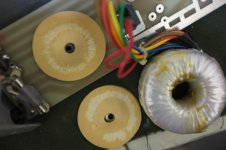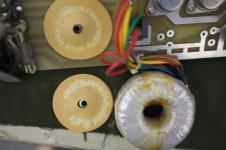Yeah, if you’re not deafening yourself or trying to shake a dance club in California off into the ocean, then a 3kVA trafo won’t heat up at all. Crest CA18 used a 2.5 kVA and the heat sink temp would cause shutdown long before the trafo was in any danger. And that would take bridged 4 ohms with “plug the subwoofer in the wall” one note bass for extended periods of time to do. It has a 30 amp plug.
Potted centers are often done for mechanical robustness, especially when they are big and HEAVY. Used with a thick foam washer at the bottom, then the bolt tightened down very tightly, you could then drop the amplifier off a truck and have it still work.
Potted centers are often done for mechanical robustness, especially when they are big and HEAVY. Used with a thick foam washer at the bottom, then the bolt tightened down very tightly, you could then drop the amplifier off a truck and have it still work.
That depends on the switch-on current surge.jean-paul said:A 3 kVA transformer without any slow start will have the breaker switch off every time it is switched on.
Halve wave rectification can cause the mains primary current to be larger in one direction campared to the opposite direction. That causes a DC magnetising current component in the primary.You also misunderstand DC component on the mains voltage.
Yes, my university assessor gave me grade "A" for practicals for nothing.In fact you misunderstand many items.
You seem to like Flame Wars, well, I like reading them, and having a good lough, but the moderators definitely don't like them, and I am going to respect their standing.If that is university level then I am glad I skipped.
Thanks.
The circuit topology completely excludes the possibility of any DC present on the primary side. DC has to be deliberately introduced like using halve wave rectification.
Heavy half wave loads on your AC line can cause a small DC offset (and 2nd HD) so don’t think that it *can’t* come in from your wall socket. It can be caused by something besides your amplifier - perhaps even from the neighbor’s house. And the transient response of an inductive load being switched on somewhere besides the zero crossing will include a DC component, which takes time to decay. The time constant can be surprisingly long.
Last edited:
Guy's
Currently around here people are trying to make a living, so people are welding, some have cooler rooms working for working meat. That is within suburbs. We get 3 phase in boxes outside on the pavement, It gets devided between 6 houses. So 2 houses houses on a phase. So those motors for cooling will have an effect on your supply. I do not know what Inverter welders will do. I think all those loads will also create harmonics and devious stuff on your AC line.
Currently around here people are trying to make a living, so people are welding, some have cooler rooms working for working meat. That is within suburbs. We get 3 phase in boxes outside on the pavement, It gets devided between 6 houses. So 2 houses houses on a phase. So those motors for cooling will have an effect on your supply. I do not know what Inverter welders will do. I think all those loads will also create harmonics and devious stuff on your AC line.
The circuit topology completely excludes the possibility of any DC present on the primary side. DC has to be deliberately introduced like using halve wave rectification.
We are talking mains conditions here, which come from "outside" and over which you (your amplifier) have no control whatsoever.
You get what you get into your building and if it has a DC *component* , something as simple as waveform assymetry, caused by heavy assymetrical loads "outside", then so be it.
Just out of curiosity, read some of the numerous threads about how to correct for that in this very Forum.
In my view, most are clumsy, involving large capacitors, solution looks worse than the problem to me
Basically agree.A 3 kVA transformer without any slow start will have the breaker switch off every time it is switched on.
Depends on breaker switch rating of course, the big turn on pulse will definitely be there.
Maybe not triggering all breakers in all cases, definitely a nuisance.
Well,yes, by definition.That depends on the switch-on current surge.
That said, same power Toroidals are low impedance (the good news is that they have better regulation) which means way higher turn on pulse than same power EI ones.
Yes, that´s one common cause and depends on you, it´s also contemplated in transformer design Math, but we are talking Mains DC component.Halve wave rectification can cause the mains primary current to be larger in one direction campared to the opposite direction. That causes a DC magnetising current component in the primary.
Search around, it is a very real problem.
Normally transformers above a certain VA rating (230V area) are switched on with inrush current protection. Maybe a class D breaker will cut the cake but inrush protection is elegant (and here mandatory). In normal homes 230V class B breakers are used. I think the limit is here 500VA for transformers. It is done with NTC’s from 500VA till 1000 VA.
Last edited:
I was pretty sure to find an instructive example "next week", now
it is only one day.
Pictures show a small light weight toroidal mains transformer with
only about 60 mm diameter and the mounting material, 50 mm.
It can be clearly seen that the coil is only supported in a small area
and mechanical force is concentrated on a small number of windings.
The rubber or similar material of only 1 mm thickness is dried out and
hard in the meantime.
In order to prevent shorts and burnout I add layers of soft rubber on
top and bottom.
it is only one day.
Pictures show a small light weight toroidal mains transformer with
only about 60 mm diameter and the mounting material, 50 mm.
It can be clearly seen that the coil is only supported in a small area
and mechanical force is concentrated on a small number of windings.
The rubber or similar material of only 1 mm thickness is dried out and
hard in the meantime.
In order to prevent shorts and burnout I add layers of soft rubber on
top and bottom.
Attachments
That is advanced level Physics. I have university level. The power factor also features in mechanical work using the dot product of two vectors, which are, the force vector and the displacement vector. The definition of the dot product is:
If that's advanced level physics, then I'm Einstein's daddy.
I understood this stuff before I stepped foot in a University.
No! A fuse does not prevent transformers to blow (=become open circuit) as you can read in the first post which contains the subject. ...
I do not see where a fuse is mentioned in the first post, and by the way
"blown transformer" is short windings most of the time, not "open circuit"
(the occasional thermo fuse opening the primary circuit will step in later).
Apart from that, your statement is highly questionable, if not plain b..wrong
and misleading other forum members. Why should anyone use a primary
fuse then ?
Pretty standard with toroids. Hardly a reason for normal quality toroids to break down.
This was in reply to my previous post, no. 70.
As I explained before, and more than one time, this is the reason for
unnecessary failure of toroids with standard mounting procedure. You
call it "pretty standard" - does it mean that we should leave it as it is ?
No, this is the most common "reason for normal quality toroids to break
down" from daily repair experience. Again, if you did not see or still do
not believe it it go back to post 4. No apparent reason to deny this.
As in your first quote, extraordinary statements require extraordinary proof.
As far as "quality toroids" are concerned the pictures in post 70 are from
a Krell preamp supply and the transformer manufacturer is the one with a
hedgehog as company logo. These are the most frequently seen xformers
as far as I know and again toroidal transformers mounted this way fail
when undue pressure on (crossed) windings leads to wire shorts.
You probably do not know it, but a short in winding may lead to overload
and burnout of the coils and especially when not fuse protected.
You can easily check this at home with a spare transformer. No need to
argue any more - and you will not tell forum members any more that a
thin enameled wire insulation "hardly" fails ?
OK then - and what about this earlier one :
If it are the windings getting shorted as indicated by a person that seems to know more then the extra rubber is to be done. It does not make any difference if you use them or not when it is a technical complaint causing electrical complaints. It does make a difference if you take measures as soon as possible as (if all the info is correct) you will prevent a failure and thus save frustration and money. That seems a better idea than waiting till it breaks down.
Finally in early agreement ..
- Home
- Amplifiers
- Solid State
- How often should transformers blow

